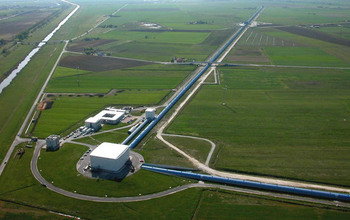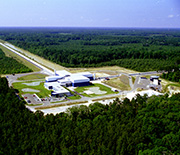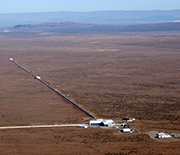News Release 17-096
LIGO and Virgo observatories jointly detect black hole collision
Discovery launches new era of gravitational wave science

Aerial view of the Virgo site, including the two perpendicular arms of its interferometer.
September 27, 2017
This material is available primarily for archival purposes. Telephone numbers or other contact information may be out of date; please see current contact information at media contacts.
In August, detectors on two continents recorded gravitational wave signals from a pair of black holes colliding. This discovery, announced today, is the first observation of gravitational waves by three different detectors, marking a new era of greater insights and improved localization of cosmic events now available through globally networked gravitational-wave observatories.
The collision was observed Aug. 14 at 10:30:43 a.m. Coordinated Universal Time (UTC) using the two National Science Foundation (NSF)-funded Laser Interferometer Gravitational-Wave Observatory (LIGO) detectors located in Livingston, Louisiana, and Hanford, Washington, and the Virgo detector, funded by CNRS and INFN and located near Pisa, Italy.
The detection by the LIGO Scientific Collaboration (LSC) and the Virgo collaboration is the first confirmed gravitational wave signal recorded by the Virgo detector. A paper about the event, a collision designated GW170814, has been accepted for publication in the journal Physical Review Letters.
"Little more than a year and a half ago, NSF announced that its Laser Interferometer Gravitational Wave Observatory had made the first-ever detection of gravitational waves, which resulted from the collision of two black holes in a galaxy a billion light-years away," said NSF Director France Córdova. "Today, we are delighted to announce the first discovery made in partnership between the Virgo gravitational-wave observatory and the LIGO Scientific Collaboration, the first time a gravitational wave detection was observed by these observatories, located thousands of miles apart. This is an exciting milestone in the growing international scientific effort to unlock the extraordinary mysteries of our universe."
The detected gravitational waves -- ripples in space and time -- were emitted during the final moments of the merger of two black holes, one with a mass about 31 times that of our sun, the other about 25 times the mass of the sun. The event, located about 1.8 billion light-years away resulted in a spinning black hole with about 53 times the mass of our sun -- that means about three solar masses were converted into gravitational-wave energy during the coalescence.
"This is just the beginning of observations with the network enabled by Virgo and LIGO working together," says LSC spokesperson David Shoemaker of the Massachusetts Institute of Technology (MIT). "With the next observing run planned for fall 2018, we can expect such detections weekly or even more often."
LIGO has transitioned into a second-generation gravitational-wave detector, known as Advanced LIGO, that consists of two identical interferometers. Beginning operations in September 2015, Advanced LIGO has conducted two observing runs. The second observing run, "O2," began Nov. 30, 2016, and ended Aug. 25, 2017.
The Virgo detector, also now a second-generation detector, joined the O2 run Aug. 1, 2017 at 10:00 a.m. UTC. The real-time detection Aug. 14 was triggered with data from all three LIGO and Virgo instruments.
"It is wonderful to see a first gravitational-wave signal in our brand new Advanced Virgo detector only two weeks after it officially started taking data," says Jo van den Brand of Nikhef and Vrije Universiteit Amsterdam, spokesperson of the Virgo collaboration. "That's a great reward after all the work done in the Advanced Virgo project to upgrade the instrument over the past six years."
When an event is detected by a three-detector network, the area in the sky likely to contain the source shrinks significantly, improving distance accuracy. The sky region for GW170814 has a size of only 60 square degrees, more than 10 times smaller than the size using data available from the two LIGO interferometers alone.
"Being able to identify a smaller search region is important, because many compact object mergers -- for example those involving neutron stars -- are expected to produce broadband electromagnetic emissions in addition to gravitational waves," says Georgia Tech's Laura Cadonati, deputy spokesperson for the LIGO Scientific Collaboration. "This precision pointing information enabled 25 partner facilities to perform follow-up observations based on the LIGO-Virgo detection, but no counterpart was identified -- as expected for black holes."
"With this first joint detection by the Advanced LIGO and Virgo detectors, we have taken one step further into the gravitational-wave cosmos," says Caltech's David H. Reitze, executive director of the LIGO Laboratory. "Virgo brings a powerful new capability to detect and better locate gravitational-wave sources, one that will undoubtedly lead to exciting and unanticipated results in the future."
-NSF-
-
LIGO operates two detector sites. The Livingston, Louisiana, site is pictured here.
Credit and Larger Version -
The LIGO detector in Hanford, Washington.
Credit and Larger Version
LIGO is funded by the National Science Foundation and operated by Caltech and MIT, which conceived and built the project. Financial support for the Advanced LIGO project was led by NSF with Germany (Max Planck Society), the U.K. (Science and Technology Facilities Council) and Australia (Australian Research Council) making significant commitments and contributions to the project. More than 1,200 scientists from around the world participate in the effort through the LIGO Scientific Collaboration, which includes the GEO Collaboration. Additional partners are listed at LIGO Partners and Collaborations.
The Virgo collaboration consists of more than 280 physicists and engineers belonging to 20 different European research groups: six from Centre National de la Recherche Scientifique (CNRS) in France; eight from the Istituto Nazionale di Fisica Nucleare (INFN) in Italy; two in The Netherlands including Nikhef; the MTA Wigner Research Centre for Physics in Hungary; the Polgraw group in Poland; the University of Valencia in Spain; and the European Gravitational Observatory, the laboratory hosting the Virgo detector near Pisa in Italy.
Media Contacts
Amanda Hallberg Greenwell, NSF, (703) 292-8070, email: agreenwe@nsf.gov
Severine Perus, Virgo-EGO Communication Office, email: severine.perus@ego-gw.it
Whitney Clavin, Caltech Communications, (626) 395-1856, email: wclavin@caltech.edu
Kimberly Allen, Deputy Director, MIT News Office, (617) 253-2702, email: allenkc@mit.edu
Jason Maderer, Georgia Institute of Technology, (404) 385-2966, email: maderer@gatech.edu
The U.S. National Science Foundation propels the nation forward by advancing fundamental research in all fields of science and engineering. NSF supports research and people by providing facilities, instruments and funding to support their ingenuity and sustain the U.S. as a global leader in research and innovation. With a fiscal year 2023 budget of $9.5 billion, NSF funds reach all 50 states through grants to nearly 2,000 colleges, universities and institutions. Each year, NSF receives more than 40,000 competitive proposals and makes about 11,000 new awards. Those awards include support for cooperative research with industry, Arctic and Antarctic research and operations, and U.S. participation in international scientific efforts.
Connect with us online
NSF website: nsf.gov
NSF News: nsf.gov/news
For News Media: nsf.gov/news/newsroom
Statistics: nsf.gov/statistics/
Awards database: nsf.gov/awardsearch/
Follow us on social
Twitter: twitter.com/NSF
Facebook: facebook.com/US.NSF
Instagram: instagram.com/nsfgov




